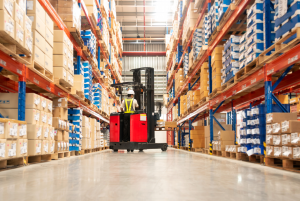The Power of Vertical Space: High-Density Warehouse Storage
When it comes to logistics and supply chain management, efficiency and optimisation are essential to ensure operations run smoothly. One key area where businesses can gain a huge advantage is by making better use of high-density warehouse storage solutions. Not only does this help improve operational flow, but reduces costs. Let’s take a look at the benefits, methods, and important things to consider when implementing high-density warehouse storage solutions.
Maximising Space
As consumer demand grows, and speed of delivery becomes even more essential, improved storage solutions are key. Expanding floor space is an incredibly expensive and often impractical option, so using vertical storage space is a much more efficient alternative.
Traditional storage solutions often leave vertical space underutilised, so by opting for high-density storage systems, there are lots of opportunities for space savings. With more room for storing goods, operations are streamlined and overhead costs like rent and electricity are reduced.
Types of High-Density Warehouse Storage Solutions
There are lots of different ways to capitalise on vertical space in warehouses, and each method depends on the specific needs of the business.
1. Pallet racking systems
Pallet racking is one of the most popular high-density storage systems, and they come in various configurations:
● Selective pallet racking – allows direct access to each pallet, perfect for warehouses stocking a variety of goods but have high volume storage needs.
● Drive-in/drive-through racking – designed for high-density storage of similar items, forklifts are able to easily deposit or retrieve pallets.
● Push-back racking – this is when pallets are stored on inclined rails, allowing for deep stacking and easy access to the most recently stored items.
● Pallet flow systems – pallets are moved along sloped lanes, this storage solution is ideal for a first-in, first-out inventory system.
2. Mezzanine floors
Mezzanine floors can easily double or triple the usable space within warehouses, without having to purchase any more square footage. These platforms mean businesses can create extra office space or workstations above the main warehouse floor area.
3. Vertical Lift Modules (VLM)
VLMs are automated systems, where a series of trays are stored vertically and deliver items to an operator at a central pick-up point. This warehouse system suits businesses who sell lots of small items, and can significantly improve retrieval times.
4. Automated Storage & Retrieval Systems (ASRS)
ASRS are computer-controlled systems that automatically place and retrieve items from specific locations in a warehouse. This removes the need for human intervention, helping to reduce errors and therefore improve efficiency.
Benefits of High-Density Warehouse Storage Solutions
1. Increase storage capacity
The main, most obvious advantage of high-density warehouse storage solutions is the increase in storage capacity. Utilising vertical space allows businesses to store more goods within the same size warehouse, without the need for relocating operations.
2. Improved operational efficiency
Inventory management is much more streamlined with high-density warehouse storage solutions. Combining automation with advanced racking configurations, this means items are not only stored more efficiently but also can be retrieved more quickly. Bottlenecks in the supply chain are therefore significantly reduced.
3. Cost savings
Optimising vertical space means there is no need to purchase additional warehouse space. By utilising automated systems, labour expenses are also reduced which can help with operational costs.
4. Enhanced safety
Modern high-density warehouse storage solutions are designed to be safer than traditional options. Racking structures are a lot more secure, and safety barriers also reduce the risk of accidents in the workplace.
5. Scalability
Growth is at the forefront of most business owner’s minds. A high-density warehouse storage system can be scaled up or down incredibly easily, to meet the changing customer demands. This helps businesses to remain flexible and be more efficient.
6. Sustainability
With businesses focusing more on sustainability, high-density storage solutions are becoming even more popular. By optimising space usage, there is less demand for new construction of warehouses, thus minimising the environmental impact. Integrating automation can help further by lowering energy consumption.
The power of vertical space should not be overlooked. High-density warehouse storage systems provide a practical, cost-effective way of storing large volumes of goods without huge additional expenditure. As businesses continue to grow and scale, investing in vertical storage solutions will help to provide a competitive edge in a thriving industry.
For advice on how to implement vertical storage solutions within your warehouse, get in touch with Logical Storage Solutions. Our expert team are on hand to find a solution to any storage problem, so call us on 0845 689 1300, or email [email protected].










 Facebook
Facebook Twitter
Twitter LinkedIn
LinkedIn